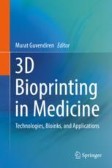Search
Search Results
-
Human mesenchymal stromal cells-laden crosslinked hyaluronic acid-alginate bioink for 3D bioprinting applications in tissue engineering
Three-dimensional (3D) bioprinting is considered one of the most advanced tools to build up materials for tissue engineering. The aim of this work...

-
3D bioprinting patient-derived induced pluripotent stem cell models of Alzheimer’s disease using a smart bioink
BackgroundAlzheimer’s disease (AD), a progressive neurodegenerative disorder, is becoming increasingly prevalent as our population ages. It is...

-
The one-step fabrication of porous hASC-laden GelMa constructs using a handheld printing system
The fabrication of highly porous cell-loaded structures in tissue engineering applications has been a challenging issue because non-porous cell-laden...

-
3D Bioprinting of Hyaline Cartilage Using Nasal Chondrocytes
Due to the limited self-repair capacity of the hyaline cartilage, the repair of cartilage remains an unsolved clinical problem. Tissue engineering...

-
Osteocyte Spheroids as a Live-Cell Additive Proposed as a Component in the Compounding of Biofabricated Materials for Engineered Bone Tissue: Formation and Biological Performance
PurposeTo proposes osteocyte spheroids as a live-cell additive for biofabricated materials in engineered bone tissue.
MethodsThe osteocytes were...

-
Fabrication of Ready-to-Use Ex Vivo Human Skin Models for Chemical Testing: Current Status and Challenges
The skin is the largest organ of the body, composed of the epidermis, dermis, and subcutaneous tissue, each with unique functions. The development of...
-
Semisolid Extrusion Printing and 3D Bioprinting
This chapter provides an insightful overview of two transformative technologies in the realm of additive manufacturing: semisolid extrusion printing...
-
Integrating bioprinting, cell therapies and drug delivery towards in vivo regeneration of cartilage, bone and osteochondral tissue
The biological and biomechanical functions of cartilage, bone and osteochondral tissue are naturally orchestrated by a complex crosstalk between...

-
New Insights into the Applications of 3D-Printed Biomaterial in Wound Healing and Prosthesis
Recently three-dimensional bioprinting (3D-bioP) has emerged as a revolutionary technique for numerous biomedical applications. 3D-bioP has...

-
3D Bioprinting Strategies for Articular Cartilage Tissue Engineering
Articular cartilage is the avascular and aneural tissue which is the primary connective tissue covering the surface of articulating bone. Traumatic...

-
3D bioprinted tumor model: a prompt and convenient platform for overcoming immunotherapy resistance by recapitulating the tumor microenvironment
BackgroundCancer immunotherapy is receiving worldwide attention for its induction of an anti-tumor response. However, it has had limited efficacy in...

-
Bioprinting for Therapeutics
The pharmaceutical sector is fueled by novel, high-value products that result from research and development. We can all agree that the pharmaceutical...
-
Bioprinting in Personalized Medications
Technology advancements are being sparked by a rising desire for controlled assembly of physiologically relevant materials with predetermined...
-
Materials as Bioinks and Bioink Design
This chapter summarizes the major concepts and recent progress in the design and formulation of bioinks for 3D bioprinting. Bioinks encompass cells...
-
3D bioprinting using a new photo-crosslinking method for muscle tissue restoration
Three-dimensional (3D) bioprinting is a highly effective technique for fabricating cell-loaded constructs in tissue engineering. However, the...

-
3D Bioprinting in Tissue Engineering and Regenerative Medicine: Current Landscape and Future Prospects
Tissue engineering and regenerative medicine typically involve design and development of a biocompatible and bioresorbable scaffold, followed by...
-
3D Bioprinting of Induced Pluripotent Stem Cells and Disease Modeling
Patient-derived induced pluripotent stem cells (iPSCs), carrying the genetic information of the disease and capable of differentiating into...
-
3D Bioprinting of Skin Tissue Model
The challenges and potential of using tissue engineering and regenerative medicine to create functional skin tissue constructs. While traditional...
-
3D bioprinted cancer models: from basic biology to drug development
Effort invested in the development of new drugs often fails to be translated into meaningful clinical benefits for patients with cancer. The...

-
Initiating and Facilitating Brain Repair: Factors, Principles, and Mechanisms
Introduction: Acute injuries to the brain result in a wide range of sequelae, and several factors contribute to the severity of a brain lesion,...
